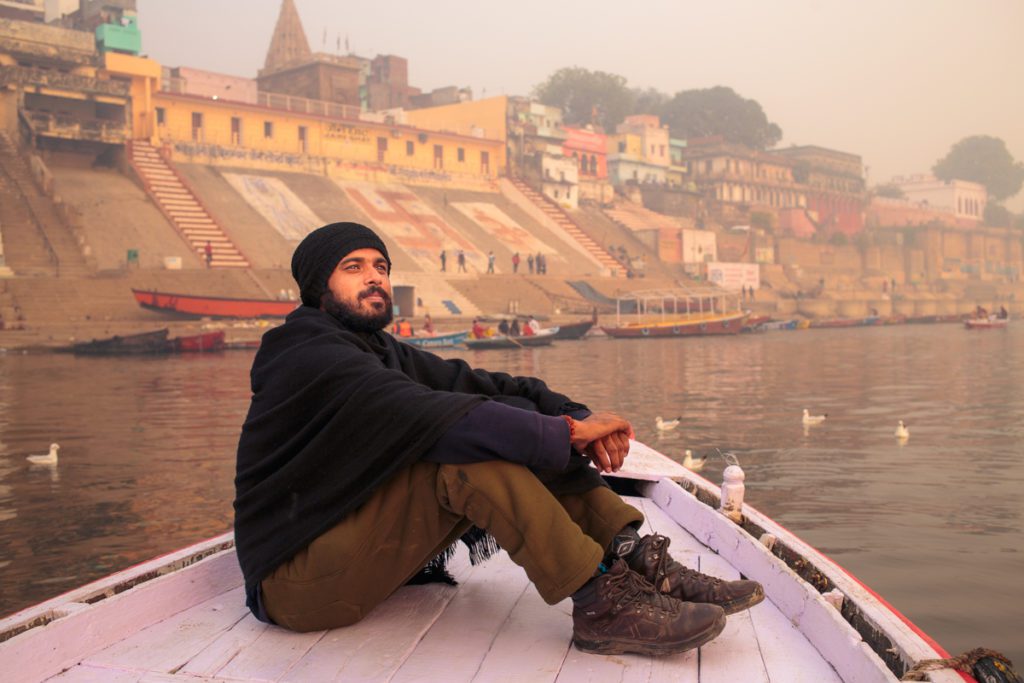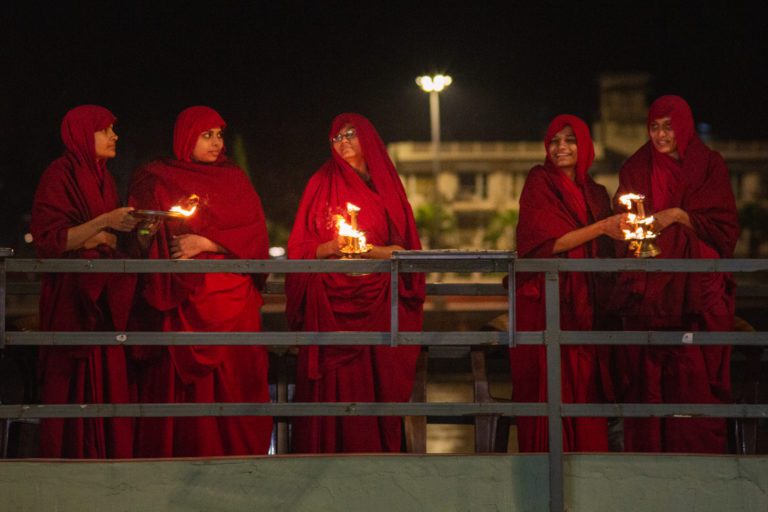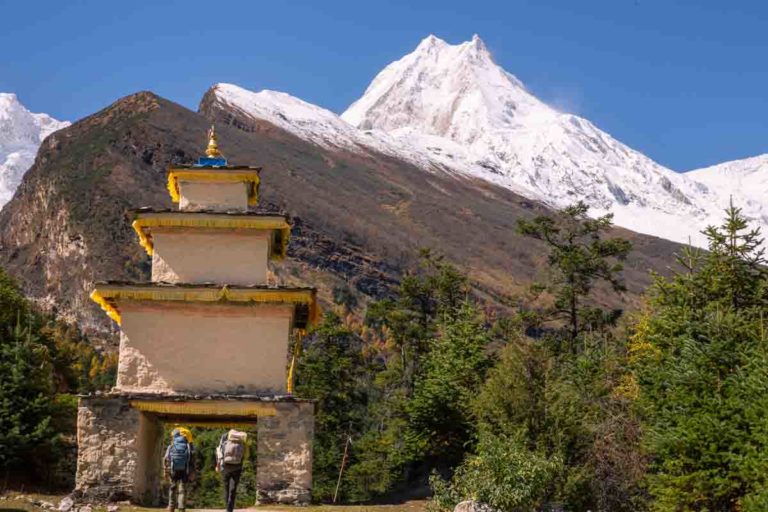Who the f*ck are you?! someone from the crowd yelled out. I’m nobody! I replied with a wry smile as I kept waving to the thousands of onlookers from my horse drawn carriage. After forty five minutes, this sudden attention was beginning to be too much.
Pangs of self consciousness at the Shrivarati Festival in Varanasi





Varanasi is one of the world´s oldest cities. Kashi, its ancient name, was associated with a kingdom of the same name of 2,500 years ago. The Lion capitol of Ashoka at nearby Sarnath, has been interpreted to be a commemoration of the Buddha’s first sermon there in the fifth century BC. Hindus believe that dying here and being cremated along the Ganges river banks allows the cycle of rebirth to be broken and salvation to become possible. The city is known worldwide for its many ghats, steps leading down the steep river bank to the water, where pilgrims perform rituals. Poets, writers, holy figures and a fusion of the intellectual and cultural elite have had their foundations connected to this place.
The city of Benaras (Varanasi) represents India religiously and intellectually, just as Paris represents the political Sentiments of France. There are few cities in the world of greater antiquity, and none that have so uninterruptedly maintained their ancient celebrity and distinction.
James Princep – The Sacred City of Hindus: An account of Benaras in ancient and modern times
During the course of my life, these images of cremations and devotees doing their rituals had always struck a chord with me.
What I wasn’t ready for, was the Varanasi pulse with so much activity going on it’s streets, parallel to all this religious devotion.


My host in Varanasi, Vibhor, gave me sound advice on what a first time visitor should take in. Only a few blocks away, Vibhor suggested that I take a look at the Bharat Mata Mandir, or Mother India temple. Instead of traditional statues of gods and goddesses, this temple has a huge map of an undivided India carved in marble. This temple had over 50 sculptors working on it during the space of six years and it is a full on 3D depiction of the Greater India area including Pakistan, Tibet, Nepal, Bhutan, Bangladesh, Sri Lanka and Burma. It was opened by the great Mahatma Ghandi in 1936 as a salute to the dedication of all patriots and freedom fighters throughout the course of Indian history.








The banter was quick and light between us. Abishek and his mate had a glint in their eye and they were maybe a little surprised to see a foreigner enjoying this not so well known gem here in Varanasi.
Yeah I love India, I said. You guy’s just have to stop beating us in the cricket, I added to which they both gleefully rejoiced in. Australia had just lost it’s test match to the host nation India, and I thought that I could use this to my advantage in gain goodwill in random people who asked me about where I was from and what I thought about their country.
But it was now my turn to ask them something in return:
What are your opinions on Mahatma Ghandi?
These two men were quick with their reply. Yes, we respect the works of the Mahatma and Chandrasekar Aajad, but we both are more followers of the philosophy to Bhagat Singh. Do you know about him, they asked me inquisitively? I shook my head. They both went on to explain the actions and short life of this Indian revolutionary who had borrowed philosophies from both the Bolshevik and Anarchy movements. Unlike Ghandi, Singh believed in direct action in order to restore justice for the abhorrent crimes that the British Empire had elicited on India’s people. He was a young scholar who took both theology and fate into his own hands through assassination and guerrilla warfare. He was responsible for the bombing of the Dehli congress which didn’t cause fatalities, but was an attempt to protest about the extreme legislations that were being passed by the then congress. Arrested, he and his associates were then sentenced to life imprisonment for detonating a “smoke bomb.” As time progressed and their actions became the spark that caused widespread (violent) action throughout the country by Indian youths who finally found a figure with whom they could identify with. After leading a hunger strike from jail, Singh and his close associates were sentenced to execution as the British Imperialists became more and more paranoid of the effects that Singh and his followers were beginning to inspire in their fellow countrymen. He was hung without due trial at the tender age of 23.
You need to also read up about Netalji Subhash Chandra Bose. He could have been our first Prime minister instead of Nehru.




My tour of Varanasi with Vibhor
Walking the Ghats, watching street merchants organize their wares, seeing the devotion at the different temples and eating the local cuisine at places that only the locals knew. Vibhor made my experience of Varanasi a memorable one:




















































Varanasi’s charm is easy to get a sense of but hard to express in words. Yes its an ancient city that has been (and still is) an influential part in the intelligentsia of Indian culture as well as home to many well known saints. The scattering of its 3300 odd temples of all faiths and the lining of devotees along the small and winding alleyways, whilst the local population try to get on with their day to day responsibilities. The centre of Varanasi is known to all as Kashi and not only holds the cities oldest temples, but it also backs onto the Ghats and the Ganga. Places that elicit the often devotional aspect of India. There is very little commercial paraphernalia in the city that I think contributes to the city maintaining its authentic charm. We in the west are so blasted by the commercial dollar and our vision is constantly bombarded by it either by flashing images, quotations that tell you how you should be, or sexual innuendo. To be in a place devoid of this noise is literally a breath of fresh air, even though Varanasians face challenges with the pollution problems in their air, land and water.
Dodging cow and dog shit, mopeds and motorcycles scraping you on their way past, beggars picking you out for an easy scam as dead bodies are being carried in the streets to the chants of the men who work at the cremation sites. Here, it’s full blown living!




Sarnath
Sarnath is located in a dozen of kilometers of Varanaresi. It is there, in the Deer Park, that the Buddha delivered his first teaching on the Four Noble Truths: the truth of the suffering, the truths of the causes of the suffering (the afflictive mental states and the fundamental ignorance), the truth of the possibility of the cessation of suffering, and the truth of path that leads to this cessation.


The Buddha’s first teaching was called the Dhammacakkappavattana Sutta, which means the Turning of the Wheel of Truth. It was given on the full-moon day of July, called Asalha.
This discourse was given to the five ascetics who were his former companions, at the Deer Park in Isipatana (now called Sarnath). The Buddha started the discourse by advising the five ascetics to give up two extremes. These were indulgence in sensual pleasures and the tormenting of the body (self-indulgence and self-mortification).
He advised against too much sensual pleasure because these pleasures were base, worldly, not noble and unhelpful in spiritual development. On the other hand, tormenting the body was painful, not noble and also unhelpful in spiritual development. He advised them to follow the Middle Way, which is helpful in seeing things clearly, as they are, and in attaining knowledge, higher wisdom, peace, and enlightenment or nirvana. The Buddha then taught the five ascetics the Four Noble Truths. They are:
Everything in this world is full of suffering, and the cause of suffering is craving. The end of suffering is nirvana. The way to the end of suffering is via the Noble Eightfold Path.
Gautama Buddha


The Buddha said that he was enlightened only after he understood these Four Noble Truths.
The Noble Eightfold Path has eight parts or factors:
1. Right understanding means to know and understand the Four Noble Truths.
2. Right attitude means to have three kinds of thoughts or attitudes:
(i) Thoughts of renunciation or an attitude of “letting go”.
(ii) Thoughts of goodwill to others, which are opposed to ill will.
(iii) Thoughts of harmlessness, as opposed to cruelty.
3. Right speech deals with refraining from falsehood, such as telling lies or not telling the truth; tale-bearing or saying bad things about other people; harsh words and frivolous talk such as gossiping.
4. Right action deals with refraining from killing, stealing and sexual misconduct.
5. Right livelihood deals with the five kinds of trade which should be avoided in order to lead a noble life. They are: trading in arms (weapons), living beings (breeding animals for slaughter), intoxicating drinks and poison.
6. Right effort has four parts using meditation:
(i) To try to stop unwholesome thoughts that have arisen
(ii) To prevent unwholesome thoughts from arising.
(iii) To try to develop good thoughts
(iv) To try to maintain good thoughts that have arisen
7. Right mindfulness is also fourfold. It is mindfulness of the body, mindfulness of feelings/sensations, mindfulness of thoughts passing through the mind and mindfulness of Dharma.
8. Right concentration is one-pointedness of mind as developed in meditation.








The serenity that I felt in this place was unique. I felt an extreme peace inside of me as I walked around and sat under trees observing both visitors and pilgrims alike. I think we all felt touched by Buddha’s presence there. It was easy to sit still and let my thoughts come and go. It was beautiful to observe others doing the same.
My observations at Sarnath
Maha Shivatri – an experience that blew my mind!


I don’t know even know how to begin to talk about this experience. First of all, the Maha Shivatri is a notable festival in Hinduism, marking a remembrance of “overcoming darkness and ignorance” in life and the world. It is observed by remembering Shiva and chanting prayers, fasting and meditating on ethics such as honesty, non-injury to others, charity, forgiveness, and the discovery of Shiva.
However, there were some blatant facts I found a little overwhelming.
I was in India’s most holy city in one of their biggest festivals! There were going to be over two million on the streets of Varanasi! It was also 35 degrees!
I was blessed that I had Vibhor not only as my guide, but also as a man who could extract me out of some sticky situations.
After seeing the build up from the day, Vibhor and I came home to rest before going back to the actual Maha Shrivatri celebrations. Tradition has it that one stays awake the whole night in order to chant and welcome in the new energy in order to cleanse oneself. In the back of my head, I couldn’t quite comprehend how anymore people could be squeezed into this ancient city, but India is always full of surprises and if there is one rule that applies here – expect the unexpected!
We arrived to witness the preparations taking place. Horse carriages stood lined up with their carriages equipped with enough blinking lights to look like a UFO. The costumes and make up to the people who were to be on parade was of Latin America standard. There were mostly depictions of the various Hindu gods, with the main focus being of course on Shiva. Vibhor was moving around quite rapidly and snapping photo’s of everything going on. I had my camera with me, but I was already exhausted by the booming music and moshpit like atmosphere. I sat down and wondered if it was at all possible for us to see all that was going on from the comfort of a rooftop.
The small crowd around me witnessed me go from being bitch slapped by an elderly woman, to becoming a show piece for the whole procession.
The unpredictability of a lone traveller huh?
Then Vibhor motioned for me to follow him as we saw that the procession was about to get under way. Fireworks were exploding, techno music was blasting and the throng of people for me was too much. I followed him over to the curbside where we would see the first carriages coming past. Almost immediately I was swallowed up and squeezed into a throng of people being pushed from all sides. How could people take their small children here, I thought? I lost Vibhor and then I felt someone hitting me in the back. I turned around to see a very short elderly woman looking up at me, and from what I could gather by the onlookers, she was giving me a piece of her mind in not so nice Hindi. I could only ascertain that she was blaming me for being pushed back, but I just shrugged her. This only incensed her more as a new round of slapping me and cursing began. Great! This is all I need!
Then to top it off, Vibhor saw a friend of his sitting in one of the carriages and he duly hopped on and disappeared. Now how was I going to negotiate my way around this? Then he motioned for me to come and join him on the float. The small crowd around me witnessed me go from being bitch slapped by an elderly woman, to becoming a show piece for the hole procession. But this took with it a whole new agenda, and it didn’t take long for me to understand that sticking out at a holy festival has with it a new set of challenges!
Vibhor’s friend was responsible for a carriage that had a huge picture of the founder of this procession back in 1984. On the back seat of our carriage, stood this mans photo with several Garlands draped over. I saw people bowing down out of respect to the picture of this man. I wasn’t sure how I was supposed to act. Should I ignore everyone? Anyone who knows India, knows that this just isn’t possible. Indians love to engage with you no matter if it’s in a good or bad way. I could already tell that most thought that my presence was quite comical, so I decided that it was best to acknowledge the crown in a way that seemed appropriate for a holy festival. I don’t know of too many other countries where my presence would have been tolerated in the way it was in Varanasi. It was amazing to witness where people were observing the festivities. Everywhere I looked, I was greeted by an ocean of faces. A lot could see that I was out of place but bowed to me with their hands in the Namaste position. Some wanted their children to be photographed with me. Others started laughing as I did my Indian head wobble and shouted out, Har Har Mahadev! One group of guys started laughing and as they pointed to me they yelled: Who the f*ck are you bro? I’m nobody, I yelled back. However, I did have some of the most amazing eye to eye contact with various people in the crowd where respect and love was reciprocated from both sides. Then a commotion would be heard from beside the carriage and then a dead body being transported on the backs of several men would be carted past to add to the surreal nature of the night. Death did not wait for anyone, particularly in a place where many Hindu’s last wish is to be cremated with their ashes spread in The Ganga here in Varanasi.
Then a lady in a very expensive sari suddenly boarded the carriage and gave me a disdainful look. I made room for her, and continued greeting the public. As the carriage continued, it had already been an hour and a half, and I wasn’t sure how long I could continue engaging like this. Then the lady asked: How did you come into this carriage? I explained that it was organized through my guide who knew the person in charge. She started making phone calls and I didn’t feel a lot of warm reciprocation coming from her. Then I was tapped on the shoulder. It was Vibhor who was now sitting at the front.
“Ritchie, you need to get off. People are reacting negatively to you being on here.”
I jumped off and walked beside the carriage until the end of the procession. I had experienced a piece of India from a very unique vantage point. The reactions that I received were just part of a bigger collective energy, that Indian culture nurtures. It was my first experience of this and I don’t know if I have at all been able to articulate the intensity of the moment. After a few more hours, I came home in the early hours of the morning completely exhausted. Vibhor’s mother greeted us and had made home made Parathas. Grateful to come home to home cooked food, I ate and fell into a deep sleep.
Har Har Mahadev indeed!












Epilogue
After the Mahar Shivrati I felt like I had been on a continuous drinking binge, not that I actually know what that’s like, but I felt like all my energy was used to compete with the plethora of noise and people. I did not come out of my bed the whole day after and didn’t leave my room. I couldn’t face anymore new impulses and I needed time to replenish my batteries. I awoke the following day and ventured out with the promise that if anyone stopped me, I would be open to hearing what they had to offer. I had gotten into the habit of trying to shut out my surroundings, and needed to open myself again. Just as a test, I was walking back from the barber when a guy yelled to me:
My friend, my bro! Come and taste India’s best chai!
I didn’t feel like chai and I very much doubted his statement judging by the appearance of his shop.
No thanks ji! I replied, maybe later yeah? I lied.
Then I remembered my oath to be open to everything that day. Shit!
I turned around and came back. I sat down and this smiling and friendly man served me up what was probably the best chai I had in fact tasted in India.
Bro, do you want a biscuit too?
He then proceeded to give me a packet of biscuits to go with the tea. Here I was enjoying a morning moment and soon a really pleasant conversation had taken place. His little tea shop was a hub of activity and appreciated by the local population as well. I watched workers on a building site, street dogs guarding their territories and cows looking for offerings by the locals. When I went to pay, the tea shop owner didn’t charge me for the biscuits and I paid the same amount as the locals. It was the first time I had experienced an honest shop owner.
I experienced other things in Varanasi. A young guy gave me a shave and the way he took care of me was utterly touching. I was old enough to be his dad, but he treated me like I actually was with a respect and caring that almost had me in tears. (Maybe I have been on my own for too long?)
I had met a guy on the train from Agra to Varanasi. He was a young IT student. Him and his friends rocked up at my hotel and took me to the Kashi Vishwaranath temple where I was the only foreigner allowed in at that time to evening prayer. It was a powerful experience and the energy there was much more hyped and intense that the energy I’d experienced anywhere else. Afterwards, we walked around the Ghats talking about the Northern Lights, life in Norway, why I was in India and what makes us love. We walked past the cremations, random people asking if I wanted a hit of Opium or LSD. Sitting as a passenger and riding through the streets on mopeds winding through the narrow alleys was fantastic.
Other times I just sat alone for myself and kept asking: Who am I?






This one night I decided to take a motorcycle out to the Ghats and walk around alone in the early hours of the morning. I liked the thought of walking alone, lit by the cremations and finding a place where I could sit and contemplate. When I dropped off, I walked down to the main cremation area where the whole place was ablaze. I had just taken out my wide angle lens, and positioned myself to stand in a place where I could take a photo where you could see all the flames alight. I could hear a commotion going on around me, but I just kept moving around and trying to find the best angle. Then a man grabbed my arm and asked me point blank:
Why are you taking pictures of this?
Because it is the cycle of life my friend, I said.
No, why are you not showing respect to the families? You are standing in their cremation area and have offended them!
I looked around me. To my horror, in the darkness I had crossed over and into the confines of the cremation area. My heart sank. Such cultural blunders I always try to avoid, but here I was committing arguably the most irrevocable of them. Gatecrashing a private funeral and taking pictures of it to boot!
Ashamed, I lowered my head and gave an immediate apology.
It’s not me you have to apologize to, it’s the family you have disrespected, he replied disgustedly. Follow me!
I walked back up the steps towards the Shiva temple there, to the jeers coming from the families and workers. It was a low point.
I was marched into an office and immediately told that I had to pay 10,000 rupees as compensation, as well as ask Shiva for forgiveness. Now I know what I did was wrong, but paying this amount of money had a ring of scamming to it. I asked to talk to the offended family members, but I was refused.
Instead I was marched to a ATM twenty minutes away. Great. This was not the way I had seen my night playing out. The guy who was with me went out of his way to explain to the other locals what I had done which bought more jeers. I took out the money and began the walk back to the Ghat. Maybe they were getting ready to lynch me there? But then the tone changed completely with my companion. He turned from being an angry concerned worker, to suddenly giving me a guided tour of Kashi.
Do you know about this temple sir?
He then began pointing out various places. Then he looked at me and for the first time he smiled.
You will give me nice tip for helping you sir?
Huh?! What was this?
When we got back, he then took me back down to the Ghats all the time motioning for me to follow him. Look sir, he pointed to a place that was even closer to where he had first arrested me.
Look sir, this here is a good place. Take as many pictures as you want! You give me a good tip yes?
Listen, can I just pay this fine to the family please. I don’t want to take any pictures sir. I replied.
We went back to the office and I was asked how much I was going to pay. 10000 rupees? 2000 was also an acceptable amount, the man conferred.
I looked at the man, and my new found guide who again piped up and said: don’t forget my tip.
I’ll give you 500 I said, and my deepest apologies to anyone I have offended.
Thank you sir! That’s nice of you said the man, as he pocketed my money and then walked off.
I walked on and found a Shiva temple and apologized to this much loved and powerful deity of Hindu tradition. Once again, my evening had been an adventure and the moral to the story is:
In a scamming situation, always be genuine from your side. It was one of many since I have been here in India and there will be no doubt countless more to come!


On my last evening, Devi and I went down to the ghats, hired a boat to the other side of the Ganga, and watch the sunset over Varanasi. It was the perfect way to say good bye to the most holy of city’s.
Til next time Varanasi ….









